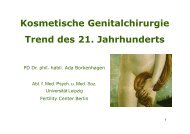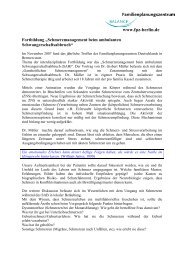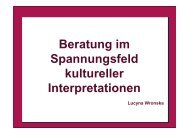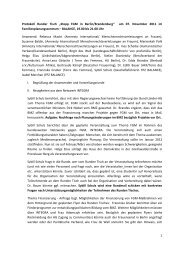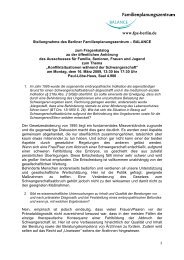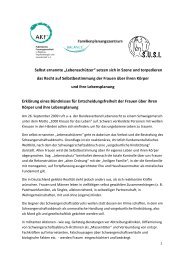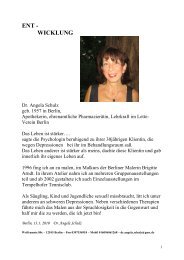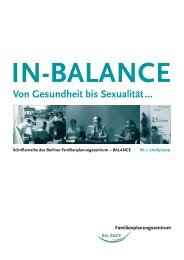Listening to African Voices - FPZ
Listening to African Voices - FPZ
Listening to African Voices - FPZ
You also want an ePaper? Increase the reach of your titles
YUMPU automatically turns print PDFs into web optimized ePapers that Google loves.
Table 29: Socio-demographic characteristics of immigrants from GambiaSocio-demographicvariableswomen(n = 33)men(n = 57)<strong>to</strong>tal sample(n = 90)Age (in years)Mean (standard deviation) 31.7 (4.8) 35.3 (6.6) 33.8 (6.1)Range 22-40 25-54 22-54Average education level (in years)Mean (standard deviation) 8.5 (5.8) 9.4 (6.8) 9.1 (6.4)Range 0-18 0-20 0-20ReligionMuslim 31 (93.9%) 55 (96.5%) 86 (95.6%)Christian 2 (6.1%) 1 (1.8%) 3 (3.3%)Traditional religion 0 (0.0%) 0 (0.0%) 0 (0.0%)None believers 0 (0.0%) 1 (1.8%) 1 (1.1%)Social statusMarried (monogamous) 16 (48.5%) 22 (39.3%) 38 (43.2%)Married (polygamous) 0 (0.0%) 1 (1.8%) 1 (1.1%)Separated/divorced/widowed 9 (28.1%) 25 (44.7%) 34 (38.6%)Never been married 22 7 (21.9%) 8 (14.3%) 15 (17.0%)Migrated from a(n)Urban area 13 (41.9%) 19 (35.2%) 32 (37.6%)Rural area 18 (58.1%) 35 (64.8%) 53 (62.4%)Residence statusUnbefristet (indefinite residence permission) 8 (24.2%) 30 (52.6%) 38 (42.2%)Befristet (temporary residence permission) 3 (9.1%) 4 (7.0%) 7 (7.8%)Duldung (<strong>to</strong>leration) 0 (0.0%) 1 (1.8%) 1 (1.1%)Others/no papers/does not answer 21 (63.6%) 17 (29.9%) 38 (42.2%)German nationality 1 (3.0%) 5 (8.8%) 6 (6.7%)Time spent in Germany (in months)Mean (standard deviation) 74.0 (40.0) 99.2 (55.4) 89.2 (51.1)Range 36-252 13-360 13-360Among the men and women interviewed, 96% of the participantsbelonged <strong>to</strong> three ethnic groups where the rates ofFGM/C are known <strong>to</strong> be very high. By far the most representedgroup in the sample were the Mandinga 28 (90%);there were also a couple of Fula and Diola. Only four mencame from groups with moderate and low FGM/C prevalence:Wolof (3) and Serer (1).In line with the ethnic group composition of the sample,90% of the participants declared that FGM/C has been takingplace in their family. Only six persons said that FGM/Cwas not part of their family traditions, two persons wereuncertain and one person abstained from answering. Theproportions of FGM/C in the family were equally high formen and for women.28 Also referred <strong>to</strong> as Mandinka, Mandingo, Bambara or Dioula.5.5.5.3. Women and girls concernedOut of the 33 women interviewed, 27 (82%) claimed <strong>to</strong>have undergone FGM/C. One woman did not want <strong>to</strong> answerthe question. In two interviews, the researchers preferred<strong>to</strong> abstain from asking the question considering that theinterview setting did not allow them <strong>to</strong> enquire about suchintimate details. Only three women reported not <strong>to</strong> haveundergone FGM/C.Most of the women had taken part in FGM/C at the age inbetween three <strong>to</strong> seven years. The procedure was carriedout in The Gambia; only one woman reported that she hadgone through FGM/C in Cote d’Ivoire. All reports conveyedthe idea that the practice was done by traditional practitioners.One key informant interviewed during the qualitativephase described that she even underwent FGM/C two times56<strong>Listening</strong> <strong>to</strong> <strong>African</strong> <strong>Voices</strong>





